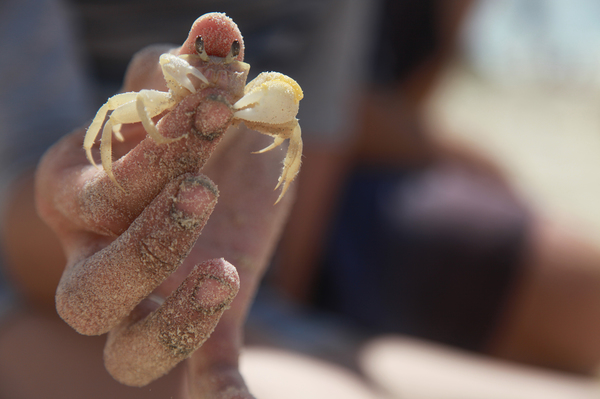USC researchers have found a new way to measure the health of sandy beach ecosystems with highly specialised drone imagery capable of mapping tiny ghost crab burrows.
In the recently-published project, two academics from USC’s Global Change Ecology Research Group worked with a science student to develop the new technique for counting populations of ghost crabs (genus Ocypode), which are considered bioindicators of beach health across the world.
Previously, scientists had to systematically walk set routes on beaches to count tell-tale burrow openings visible on the sand’s surface. The practice was costly in labour, time and effort, and it risked disturbing the habitat. As a result, surveys were typically limited to small plots, potentially yielding misleading population data.
The USC team did fieldwork at Peregian Beach to compare the manual method with their new technique that relied on a combination of cutting-edge technologies.
Aerial photos taken by low-flying drones were processed with an image-classification algorithm that used artificial intelligence to fine-tune the identification of crab burrows in the images. The burrows could then be mapped quickly and to a high degree of accuracy, even over large areas.
Senior Lecturer in Physical Geography Dr Javier Leon said it took a year to develop an algorithm that could differentiate the crab burrows from other features in the sand, such as footsteps, paw prints and shadows.
“That was the biggest challenge – and an exciting result – because we really wanted to produce accurate scientific information from the drone photos,” he said.
“Now we can apply the technique to further ghost crab research – such as measuring changes in burrow size over time – and investigate all sorts of other ecological questions such as mapping plastic litter on beaches or counting stingray feeding pits on mudflats to understand how they contribute to bioturbation (sediment disturbance).”
Professor of Global Change Ecology David Schoeman, whose research aims to identify the ecological consequences of climate change at local and global scales, co-authored the paper published in international journal Estuarine, Coastal and Shelf Science.
In the Peregian Beach case study, Dr Leon took 10 minutes to fly a drone over 2400sqm to take pictures of burrows, while Science Honours student Rachel Bycroft took about the same time to manually count burrows across just 30sqm of sand.
“That means the new drone method would take 10 minutes to cover an area that would require 13 hours of labour under the manual method, rendering the survey impractical without a large team,” Dr Leon said.
Rachel, a USC Environmental Science graduate from Maroochy River, said the project reflected her passion for the preservation of natural environments.
“It’s given me the opportunity to help sustain our beautiful beaches,” she said. “I was really interested in how fast the technologies are developing and how complex some of the algorithms are becoming, which leads to better accuracy.”
Professor Schoeman said research such as this would contribute to the ongoing health of sandy beaches and provide new techniques for monitoring plant and animal populations as they responded to climate change.
“Finding and counting animals and plants at the very edges of their geographic ranges is difficult and expensive using traditional methods,” he said.
“But with the new tools at our disposal, tasks that might have seemed daunting now could become routine. It’s exciting.”








